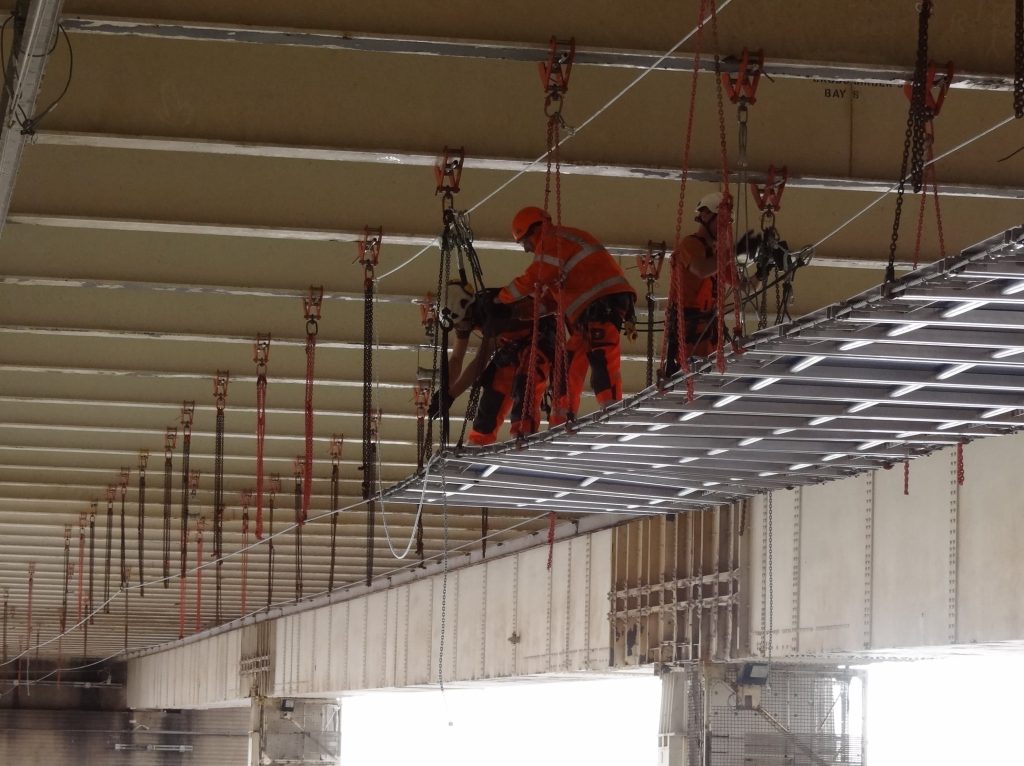
Bridge infrastructure is the backbone of modern transportation networks, yet inspecting and maintaining these critical structures remains a complex and costly endeavor. Traditional access methods—particularly tube and clamp scaffolding—have long been the industry standard. However, as infrastructure ages and budgets tighten, bridge owners and engineers are increasingly seeking smarter, safer, and more cost-effective alternatives.
Suspended bridge scaffolding systems are a modern, efficient solution that is transforming how bridge inspections are conducted. While this approach may be new to some, its advantages in terms of time, cost, safety, and adaptability make it a compelling choice for any bridge owner looking to optimize their inspection and maintenance strategies.
What Are Suspended Scaffold Systems?
Suspended scaffolds are platforms that hang from overhead structures using ropes, cables, or mechanical hoists. Unlike traditional scaffolding, which is built from the ground up using a network of tubes and clamps, suspended systems are deployed from the top down. This makes them particularly well-suited for environments where ground access is limited or non-existent—such as over rivers, highways, or steep terrain.
Time Savings: Faster Deployment, Quicker Inspections
One of the most significant advantages of suspended bridge scaffolding is the dramatic reduction in setup and takedown time. Traditional tube and clamp scaffolding can take days—or even weeks—to erect, especially on complex bridge geometries. In contrast, suspended systems can often be installed in a matter of days or hours.
This speed translates directly into faster inspections. With less time spent on access setup, engineers can begin their assessments sooner and complete them more efficiently. For bridge owners, this means less downtime, fewer traffic disruptions, and a quicker return to service—all of which are critical in minimizing public inconvenience and maximizing asset availability.
Cost Efficiency: Lower Labor and Material Expenses
Time is money, and nowhere is that more evident than in the cost comparison between suspended and traditional scaffolding. Tube and clamp systems require extensive labor for assembly, disassembly, and transport. They also involve significant material costs, including steel or aluminum tubes, clamps, base plates, and decking.
Suspended bridge scaffolding, on the other hand, require fewer components and less labor. Because they are modular and reusable, they offer long-term savings across multiple projects. Additionally, their lightweight design reduces transportation costs and minimizes wear and tear on access roads and staging areas.
In many cases, bridge owners have reported cost savings of 30–50% when switching to suspended systems for inspection and maintenance tasks.
Enhanced Safety: Reducing Risk in Challenging Environments
Safety is paramount in any bridge inspection project. Traditional scaffolding often requires workers to operate at height for extended periods during assembly and disassembly—exposing those workers to fall hazards and other risks.
Suspended bridge scaffolding mitigate many of these dangers. Since they are deployed from above, workers spend less time climbing and more time securely harnessed on stable platforms. Many systems also include built-in safety features such as guardrails, or netting edge protection, fall arrest anchors, and emergency descent mechanisms.
Moreover, suspended systems can be strategically positioned to avoid live traffic lanes, active railways, or environmentally sensitive areas—further reducing risk to both workers and the public.
Adaptability: Accessing Hard-to-Reach Areas with Ease
Bridges come in all shapes and sizes, from long-span suspension bridges to short overpasses and viaducts. Traditional scaffolding often struggles to accommodate complex geometries, especially when access is needed underneath decks or around piers.
Suspended scaffolds, such as WEB Deck® excel in these scenarios. Their modular design allows for custom configurations that can be tailored to the unique contours of any structure. Whether it’s a narrow arch, a cantilevered beam, or a cable-stayed pylon, suspended systems can be adjusted to provide safe, stable access exactly where it’s needed.
This flexibility is especially valuable for routine inspections, non-destructive testing, and localized repairs, where full-scale scaffolding would be overkill.
Environmental and Logistical Advantages
In addition to their operational benefits, suspended scaffolds offer several environmental and logistical advantages:
- Minimal Ground Disturbance: No need for heavy equipment or foundation work on sensitive terrain.
- Reduced Traffic Impact: Systems can be deployed from bridge decks, often avoiding lane closures or detours.
- Lower Carbon Footprint: Fewer materials and less transport mean a smaller environmental impact.
These factors make suspended scaffolds an ideal choice for projects in urban areas, protected ecosystems, or remote locations where traditional access methods are impractical or undesirable.
Overcoming the “Newness” Barrier
Despite their clear advantages, some bridge owners may hesitate to adopt suspended scaffolds simply because they are unfamiliar. This is understandable—public infrastructure projects are inherently risk-averse, and decision-makers often prefer tried-and-true methods.
However, the industry is evolving. Leading engineering firms, DOTs, and contractors across North America and Europe are increasingly embracing suspended access as a best practice for bridge inspection and maintenance. Case studies consistently show improved efficiency, lower costs, and enhanced safety outcomes.
To ease the transition, Axxium Distribution & Rentals Inc. can offer comprehensive support, including:
- Site assessments and engineering design
- Certified installation crews
- Training for in-house personnel
By partnering with experienced providers, bridge owners can confidently integrate suspended bridge scaffolding systems into their asset management programs—reaping the benefits without compromising on safety or quality.
Conclusion: A Smarter Way Forward
As infrastructure ages and budgets tighten, bridge owners must find innovative ways to do more with less. Suspended scaffolding systems offer a proven, practical, and powerful alternative to traditional tube and clamp scaffolding—delivering faster inspections, lower costs, and safer operations.
Whether you’re managing a rural overpass or a major urban viaduct, suspended bridge scaffolding provides the flexibility and efficiency needed to keep your bridges safe, functional, and future-ready.
Work with Axxium Distribution & Rentals to elevate your inspection strategy—literally.




